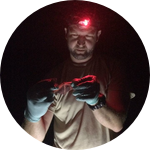Project Results
Well! This has been a long time coming, but my results are finally published. Thanks to all of your generous donations, I was able to run all of the serological assays on two years worth of coyote samples, plus some genetics!
I found genetic and antibody evidence of spotted fever group Rickettsia bacteria in coyote tissues, but we were unable to conclusively call it R. rickettsii (the species that causes Rocky Mountain Spotted Fever). That said, several pathogenic Rickettsia species occur in and around Arizona, and they are quite difficult to tell apart diagnostically. The silver lining is that they present with similar symptoms and, if caught early, can be cured with a course of Doxycycline, usually without chronic organ damage. The important thing is to get immediate medical attention in the case of flu-like symptoms accompanied by a rash, regardless of whether you remember being bitten by a tick.
Here is the link to the online-first version of the article. Currently it's behind a paywall, but you are collectively acknowledged at the end. I'll try to upload a PDF at a later date.
Thanks again for your support!
Eric
About This Project
Rocky Mountain spotted fever (RMSF) is a tick-borne bacterial infection that can cause permanent disability or death in humans, with a case fatality rate up to 28% untreated. In 2003, RMSF moved into Arizona, where it is vectored by the brown dog tick (Rhipicephalus sanguineus).
We would like to determine whether coyotes develop antibodies for RMSF - indicating that they are affected by the disease - and investigate whether they facilitate the dispersal of RMSF-infected ticks.
Ask the Scientists
Join The DiscussionWhat is the context of this research?
RMSF in Arizona typically arises only on tribal lands, which commonly have large numbers of free-roaming dogs that are not treated for ticks. The Arizona tribes have been working diligently over the past several years to treat dogs and homes for ticks and to educate their residents on responsible pet ownership. These efforts have been largely successful, but not 100% effective.
Animal control and health officials on one reservation in particular noticed that human cases of RMSF continued even when all dogs were treated with tick collars and no dogs showed symptoms or antibodies for the RMSF bacterium. This led the officials to believe that coyotes or other mammals may be responsible for dispersal of RMSF-infected ticks.
What is the significance of this project?
Conventional wisdom in the U.S. says that brown dog ticks prefer domesticated dogs, and only bite humans as accidental hosts. However, the literature lists other species as known hosts. Immature brown dog ticks parasitize small rodents, hedgehogs, and other small mammals; adults parasitize larger mammals such as wild canids, ungulates, and humans (1, 2, 3). Another paper lists cats, rabbits, rodents, and pigeons as additional hosts (4).
Knowing whether coyotes are parasitized by brown dog ticks will lead to coyote management initiatives to prevent their presence near human habitations. This is especially important on tribal lands, where anecdotal evidence suggests that coyotes are more likely to come near houses. This will improve the overall effectiveness of RMSF prevention campaigns.
What are the goals of the project?
This research will test whether brown dog ticks parasitize coyotes and whether coyotes facilitate the long-distance dispersal of the disease vector. We will collect ticks, blood, and a biopsy of ear tissue from coyotes that have been culled by game management agents to protect fawning pronghorn (Antilocapra americana).
The ticks will be identified to species. We will look for RMSF antibodies in the blood, and bacterial DNA in the skin and ticks (phase 2 of the project, which will be funded separately).
If we find brown dog ticks on coyotes, it means that coyotes play a role in the ticks' dispersal. If we find RSMF bacteria in ticks on coyotes, then we know coyotes disperse infected ticks. And if we find antibodies or RMSF bacteria in coyotes, then we'll know coyotes do get the disease.
Budget
We currently have a few more than 100 blood samples. The budget items listed here will allow us to collect 100+ more samples, optimize the serology tests, and determine presence or absence of antibodies on all 200. The fuel cost is necessary to enable us to travel to various locations throughout the state of Arizona. This is directly related to the collection of additional blood samples.
We have the opportunity to collect additional samples through a partnership with a state governmental agency. However, we don't currently have any external funding to begin diagnosing the samples we have or to pay for the necessary supplies listed above, so your contribution will enable us to move forward with our research.
Endorsed by
Meet the Team
Affiliates
Affiliates
Team Bio
Eric and Dana Green are wildlife biologists and graduate students at Northern Arizona University. They each have separate research projects, but they have complimentary skills and work well as each other's field technicians. They met as undergraduates at Missouri State University, where they worked on several projects together, culminating in two publications in preparation. "The Greens" got married in June 2014 and still enjoy doing science together.
Eric Green
Eric Green is a field naturalist and wildlife ecologist. He has a Master of Science in Biology from Northern Arizona University, a Bachelor of Science in Wildlife Biology from Missouri State University, and an Associate of Applied Science in Electronic Systems Technology from the Community College of the Air Force. In the Air Force, Eric was an electronics technician for 10 years. At Missouri State University, Eric gained a wealth of experience in field and lab techniques, working with bats, armadillos, turtles, and salamanders. His master's research found serological and genetic evidence of rickettsial pathogens in coyote tissues. Contact Eric directly at EG.Biology@gmail.com.
Dana Green
Dana Green has always had a passion for animals, but wanted to go a different direction other than veterinary medicine. After working closely with a big cat sanctuary as the Intern Director, she decided to focus on active research while earning her bachelors degree in Wildlife Biology. While earning her B.S., she actively researched behavioral ecology of salamanders, armadillos, and endangered bats. Dana is now working toward her Master of Science in Biology degree in Flagstaff, AZ. There she is focusing on predator-prey dynamics with a focus on how the prey base affects top predators. Her interests include: habitat ecology, habitat selection, predator-prey relationships, and behavioral ecology. She is currently working in collaboration with her husband, Eric Green, on various projects. Together they have two publications in preparation. Hobbies include: reading fantasy, hiking and backpacking, and painting.
Additional Information
The Centers for Disease Control and Prevention (CDC) have lots of information about RMSF.
Placeholder image of coyote used with minor cropping. By USFWS Pacific Southwest Region (Coyote at Tule Lake NWR) [CC BY-SA 2.0 (http://creativecommons.org/licenses/by-sa/2.0)], via Wikimedia Commons. License: Attribution-Share Alike 2.0 Generic.
Project Backers
- 44Backers
- 104%Funded
- $3,149Total Donations
- $71.57Average Donation






